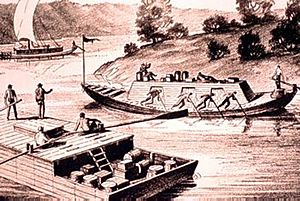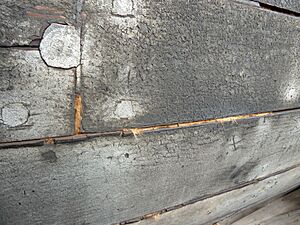Colonel Plug facts for kids
Quick facts for kids
Colonel Plug
|
|
|---|---|
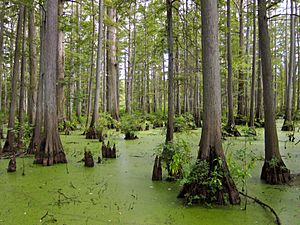
Colonel Plug and his gang of river pirates patrolled the Cache River cypress swamp, of Southern Illinois, near the confluence of the Ohio and Mississippi Rivers, hunting down helpless and unsuspecting river travelers, to attack, rob, and murder, between the 1790s–1820.
|
|
| Born | |
| Died | 1820? Cache River, present-day Pulaski County, Illinois?
|
| Resting place | Cache River, present-day Pulaski County, Illinois? |
| Nationality | American |
| Other names | Colonel Fluger, Colonel Flueger, Colonel Pflueger, Col. Plug, Last of the Boat-wreckers |
| Occupation | river pirate, criminal gang leader, state militia officer |
| Spouse(s) | Pluggy |
| Cache River Pirates | |
|---|---|
| In | Cache River, at the confluence of the Ohio River, just above the Mississippi River, in Southern Illinois |
| Founded by | Colonel Plug, Nine-Eyes |
| Years active | 1790s–1820 |
| Territory | Ohio and Mississippi Rivers, Southern Illinois, Western Kentucky |
| Ethnicity | European-American, African-American |
| Membership | ? |
| Criminal activities | river piracy, theft, fencing stolen goods, murder |
| Rivals | Samuel Mason (river pirate) |
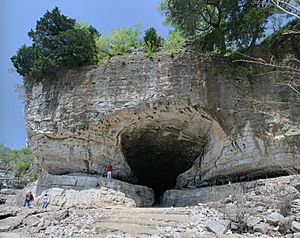

Colonel Plug (who lived sometime between the 1790s and 1820) was a legendary river pirate. He was also known as Colonel Fluger and "The Last of the Boat-Wreckers." He led a criminal gang on the Ohio River in a cypress swamp near the Cache River. His outlaw camp was supposedly located below the pirate hideout of Cave-In-Rock and the U.S. Army post at Fort Massac. This fort watched over river traffic near where the Ohio and Mississippi Rivers meet.
Contents
What Was the Cache River Swamp Like?
French-Canadien explorers called the Cache River "Cache," meaning "secret or hidden place." The first European settlers arrived in this swampy river country around 1803. The land was too wet for farming, and the cypress swamps were full of mosquitoes and venomous snakes. Many settlers got sick with malaria and died. Because the Cache River was such a difficult place to live, its hidden nature made it perfect for river pirates to hide their illegal activities.
How Did Colonel Plug Attack Boats?
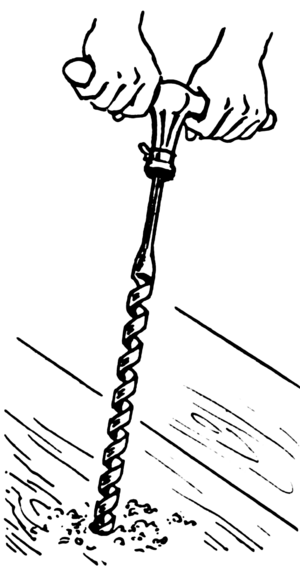
Colonel Plug's gang had clever ways to attack boats. One common tactic was for a pirate to sneak into the hull (the bottom part) of a boat. There, they would dig out the caulking between the wooden bottom planks. Caulking is a sticky mixture of cotton and oakum (a type of hemp rope fiber soaked in pine tar). It's driven into the seams to make the boat watertight. By removing it, the boat would start to sink, making it easy to attack.
Another method was to drill holes in the boat's bottom planks using an auger. Once the boat was disabled, the pirates would steal the cargo and the boat itself. They would then sell the stolen goods down the Mississippi River, often in New Orleans. It is said that Colonel Plug eventually drowned when he got trapped inside a rapidly sinking boat.
Who Was in Colonel Plug's Gang?
Colonel Plug had a wife known as "Pluggy." She was described as a very large woman with a mustache and mixed heritage. His partner and second-in-command was named "Nine-Eyes." Nine-Eyes might have been an escaped slave, a freed former slave, or a free-born Black person.
Was Colonel Plug a Real Person?
Many stories about Colonel Plug might be based on a real-life pirate from Cave-In-Rock named Samuel Mason, who also used the name "Bully Wilson." It's hard to know if Colonel Plug was a real person or just a character from folklore. Most of what we know comes from newspaper articles written by Timothy Flint in 1830. These articles, like "Col. Plug, the last of the Boat-wreckers," were published in newspapers in Cincinnati, Ohio and Rochester, New York.
Colonel Plug claimed he was from Rockingham County, New Hampshire, and had been a colonel in the New Hampshire Militia. However, there's no historical proof to back up this claim. No one with the last names "Fluger," "Flueger," or "Pflueger" (different spellings of his name) can be found in New Hampshire census records or military lists from that time. This suggests he might have been a fictional character or his story was greatly exaggerated.
Why Did River Piracy Decline?
River piracy began to decline after the first steamboat, the New Orleans, appeared on the Ohio and Mississippi Rivers in 1811. This was also the year of the huge New Madrid earthquake. Steamboats were much faster and harder to ambush than older boats. They also didn't need to stop as often for fuel, rest, or supplies, which made them less vulnerable.
Also, keelboat crews started traveling together in large, heavily armed groups, almost like small armies. They would work together to fight off criminals they found on the rivers. These changes made it much harder for pirates like Colonel Plug to succeed, leading to the end of the river piracy era.
Colonel Plug in Pop Culture
In 1955, actor Walter Catlett played Colonel Plug in a Walt Disney's Disneyland miniseries called Davy Crockett and the River Pirates. However, in the show, Colonel Plug was shown as a funny troublemaker, not the ruthless outlaw he was described as in the old stories.
Images for kids
-
Colonel Plug and his gang of river pirates patrolled the Cache River cypress swamp, of Southern Illinois, near the confluence of the Ohio and Mississippi Rivers, hunting down helpless and unsuspecting river travelers, to attack, rob, and murder, between the 1790s–1820.
-
The famous outlaw hideout of Cave-in-Rock on the Ohio River. The real-life river pirate Samuel Mason led a gang here from 1797-1799. Colonel Plug's story might be based on him.
-
Fort Massac, located down the Ohio River from Cave-in-Rock and above the Cache River. This U.S. Army frontier post helped police the Ohio River, looking for pirates like Colonel Plug.
-
An auger, a drilling tool that Colonel Plug and his river pirates used.


